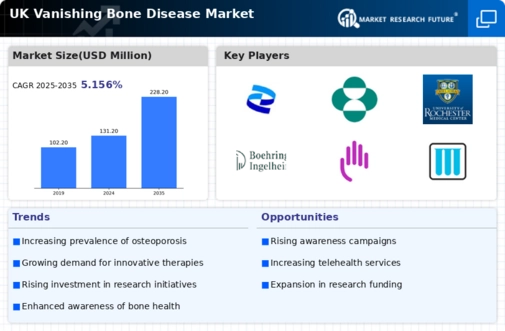Increased Healthcare Expenditure
The rising healthcare expenditure in the UK is a significant driver for the vanishing bone-disease market. Government initiatives aimed at improving healthcare access and quality are leading to increased funding for medical research and treatment options. In 2025, healthcare spending is projected to reach approximately £200 billion, reflecting a commitment to addressing various health challenges, including rare bone diseases. This financial support is likely to facilitate the development and distribution of new therapies within the vanishing bone-disease market. Additionally, as healthcare providers allocate more resources to specialized treatments, patients may experience improved access to innovative solutions, thereby enhancing their quality of life and overall health outcomes.
Rising Incidence of Bone Disorders
The increasing prevalence of bone disorders in the UK is a primary driver for the vanishing bone-disease market. Recent statistics indicate that conditions such as osteoporosis and osteogenesis imperfecta are becoming more common, particularly among the aging population. This demographic shift suggests a growing need for effective treatments and management strategies. As the population ages, the demand for innovative therapies and interventions is likely to rise, thereby expanding the market. The vanishing bone-disease market must adapt to these changing demographics by developing targeted solutions that address the specific needs of patients suffering from these debilitating conditions. Furthermore, the economic burden associated with these disorders, estimated to reach billions of £ annually, underscores the urgency for advancements in treatment options.
Advancements in Research and Development
Ongoing advancements in research and development are propelling the vanishing bone-disease market forward. The UK has seen a surge in funding for biomedical research, particularly in the field of rare bone diseases. This influx of investment is fostering innovation and the discovery of novel therapeutic approaches. For instance, recent breakthroughs in gene therapy and regenerative medicine hold promise for treating conditions that lead to bone loss. The vanishing bone-disease market is likely to benefit from these scientific advancements, as they pave the way for new treatment modalities that could significantly improve patient outcomes. Moreover, collaborations between academic institutions and pharmaceutical companies are expected to enhance the pace of development, potentially leading to the introduction of groundbreaking therapies in the near future.
Growing Collaboration Among Stakeholders
The vanishing bone-disease market is witnessing a growing collaboration among various stakeholders, including healthcare providers, researchers, and patient advocacy groups. This trend is fostering a more integrated approach to addressing the challenges associated with bone diseases. Collaborative efforts are likely to enhance awareness and understanding of these conditions, leading to improved patient outcomes. Furthermore, partnerships between pharmaceutical companies and academic institutions are expected to drive innovation in treatment development. The vanishing bone-disease market could benefit from these synergies, as they may lead to the creation of comprehensive care models that address not only the medical but also the psychosocial aspects of living with bone disorders. Such collaborations are essential for advancing research and ensuring that patients receive holistic care.
Regulatory Support for Innovative Treatments
Regulatory bodies in the UK are increasingly supportive of innovative treatments for rare diseases, including those affecting bone health. The introduction of expedited approval processes for orphan drugs is a notable trend that could benefit the vanishing bone-disease market. This regulatory environment encourages pharmaceutical companies to invest in the development of new therapies, as they can bring products to market more swiftly. The vanishing bone-disease market stands to gain from this supportive framework, which not only accelerates the availability of treatments but also enhances the attractiveness of the market for investors. As a result, the potential for increased competition and innovation is likely to drive growth in the sector, ultimately benefiting patients in need of effective solutions.

























Leave a Comment